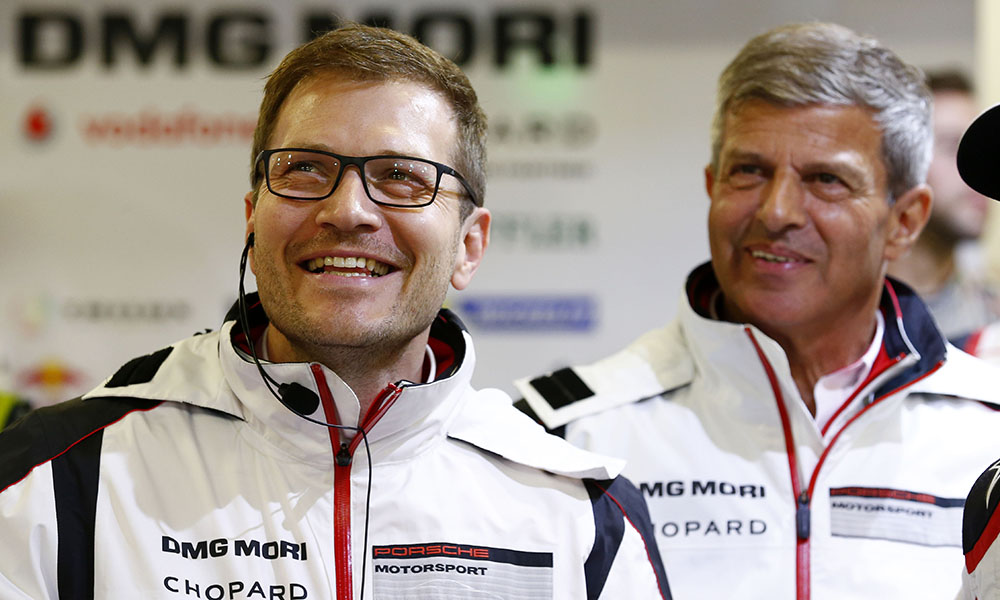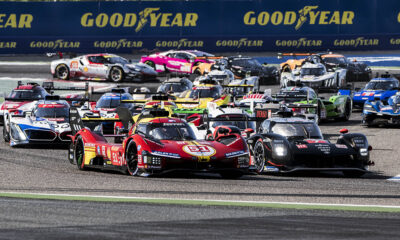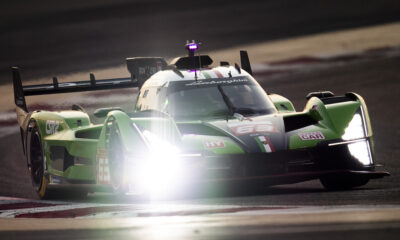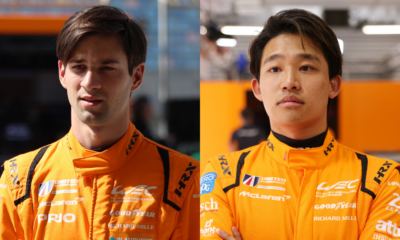
Photo: Porsche
In the second of a two-part Q&A series, Fritz Enzinger, Vice President LMP1 and team principal Andreas Seidl reflect on Porsche’s 919 Hybrid program, which came to an end in last weekend’s FIA World Endurance Championship season-ending Six Hours of Bahrain.
Which driver performance has impressed you the most?
Fritz Enzinger: “I couldn’t reduce it to a single situation. All ten LMP drivers have greatly impressed me many times over, regardless of the result.
“For example, in Fuji in 2017, we didn’t win. But it was terrific – the way Earl Bamber drove during his first WEC start stint, with a car that led the World Championship.
“Under this pressure, and in the most adverse conditions on a wet track, he was able to navigate the track in the 919 with such speed and control that he built up a twelve-second lead. We really had a knack for selecting good drivers.”
Andreas Seidl: “Instinctively the performance from the boys in the third car in Le Mans in 2015 impressed me a lot as they were pretty new to the task and yet they won.
“But on the other hand, it wasn’t surprising, because we chose three professionals after a tough selection process and gave them the same levels of preparation as the regular drivers right from the outset. So why would they be slower?
“Throughout the years, we always had the luxury of having the best and most balanced driver line-up. The error rate from the drivers was extremely low.”
What was your first thought when Mark Webber crashed in the 2014 final race?
FE: “That was bad. It was the first time in this project when I really became aware of how dangerous these races can be.
“When Mark approached us during his time in Formula 1 and said he wanted to be part of our LMP programme, I could hardly believe it. But he was determined to help build the team, and to immerse himself in this new field.
“We were so happy when he gave us a sign after the impact to let us know that he was reasonably okay! That race in São Paulo was the one that moved me the most: The accident, the agonising uncertainty, the relief and then minutes later the first victory by the other car.
“At that point, an enormous pressure was lifted off me and certainly everyone else in the team. It confirmed that if the car makes it round the track, it is fast enough.
“Everything came together on the day. But it took Mark a while to recover afterwards.”
AS: “My first thought was: Come on mate, get on the radio and let us know you’re there! Fortunately, Mark did this in a very quiet voice.
“In such a situation we too have only what is shown on TV. Seconds feel like minutes. At the same time we are responsible for the second car and ask ourselves if a technical failure might have been the reason and perhaps could put the other driver in danger.
“Driver safety always is the highest priority, but you also cannot unnecessarily retire a car. To make such safety critical decision instantly with limited information is the most difficult to do in the racing business.”
Is there a driver who you would have liked to put in a Porsche 919 Hybrid?
FE: “Yes, Patrick Dempsey during a test. But it turned out that we couldn’t give him enough time to properly get used to the car.”
AS: “Basically, all of the best drivers from other top classes. Because I would like them to get into our 919 Hybrid and come back from their first lap with a grin on their face.
“This car is the ultimate driving machine – one that every racing driver enjoys from the moment they first feel the maximum acceleration of the hybrid system together with the combustion engine.
“And, of course, it was interesting for me to see the best drivers from other top classes compete against our drivers. That showed the high quality of our drivers.”
What was the most difficult decision you had to make?
FE: “I can’t pick out a single decision, but rather a period: In the initial phase in 2012, so many different decisions had to be made in parallel, that in hindsight is quite amazing how many of them were correct.”
AS: “My bravest decision was probably signing Earl Bamber. He came from the Porsche Supercup and had no prototype experience. This involved a certain risk.
“But he really impressed our senior race engineer and me during his first test with how quickly he got up to speed and how consistently he was able to drive a stint. We were convinced that he could do it.
“It also suited our project, taking risks when they also present a great chance of success. The most difficult decisions are always related to personnel.
“In a racing team, you experience many ups and downs that bring you closer together – you build strong relationships with your team members.
“Nevertheless, in the course of the project I had to make several decisions relating to personnel that were hard for individuals, but right for team performance.
“Those decisions were the hardest for me. But the job of the team principal is not just collecting trophies and being popular.”
How do you recall the first Le Mans race of 2014?
FE: “This race came far too early for us. We had had only a single simulation test, and with that we never managed more than six or seven hours.
“The whole test operation only really worked correctly from December, after we had suppressed the vibrations. We had just two six-hour races behind us, and even those had not gone smoothly.
“The fact that we were in the lead at Le Mans after 20 hours raised hopes in the short term that were not reasonable. The power train and the transmission defects did not come as a surprise.”
AS: “Yes, that race was definitely too early for us. We were unprepared in terms of durability for the 24 hours, nor were we operationally ready as a team to compete with the big players.
“We had stability problems, our pit stops were bad compared to the benchmark and we also didn’t have the speed. We were really lucky in the race, so it was deemed to be a partial success.
“Even though you couldn’t and shouldn’t realistically expect more in the first year of such a complex project, this race was of course below my standards.”
How and when did you actually come to terms with the first Le Mans victory in 2015?
FE: “I remember getting back to the hotel room at about midnight, but I couldn’t fall asleep right away. I was filled with relief at the achievement. I was lying in bed going over the sluggish early stages.
“I was away from Munich and without my family, living in a dull apartment building where only commuters lived. I always got back there after dark, and the stairwell smelled like packet soup. It was somewhere to sleep, nothing more.
“I remembered the deprivation. But now the race was won and that was incredibly important for Porsche. I was so wonderfully relaxed and happy that I didn’t want to fall asleep.
“I wanted to hold on to that feeling. The next morning, I was picked up at 6 a.m. It was on the way to Paris that I then saw all the congratulatory SMS messages.
“That was very real, and there were far too many to answer them all individually. So I sent the same message to all of them: Good morning! Woke up. It wasn’t a dream.”
AS: “It was only after my return home to my family in Munich that I properly felt it. Since that was when the confirmation came from Le Mans by SMS that all the technical follow-up examinations had been passed.
“I can never celebrate a racing victory immediately because I always have in the back of my mind what can go wrong later during the scrutineering. At Le Mans, the checks are particularly intensive, and last until late Monday afternoon.
“As a result, I couldn’t really celebrate properly on the Sunday evening. But once I was home, I was very happy that we had achieved success as a team for Porsche.”
How different is the Le Mans mode from normal operation?
FE: “The focus was always clear at Le Mans. Without victory at the 24 Hours, a world championship is only worth half as much.
“As early as the roll-out in December, we were always asking the decisive question: Is our package good enough for Le Mans? It was clear: If the car can win there, it can also win a six-hour race.”
AS: “There was also a big difference on an operational level. In the two weeks at Le Mans, you go through a lot of extreme situations with your team, both technical and personal. No other race compares.
“It’s a special event format, and the pressure is huge. Everyone knows that they have this opportunity only once a year; there are no second chances. The pressure of being there with Porsche, both internally and externally, is immense.
“It builds up a little more every day until the cars head for the starting grid. I was always aware that, despite the best preparation, a lot of luck is required even to finish this race, and even more to win it. But that was our mission.
“The challenge of coping as a team in this cage down in the pit is special. And I will miss it. It only happens there.”
How much does success have to do with luck?
FE: “You cannot win Le Mans without racing luck. With almost 60 cars on the track and constantly passing others, it doesn’t happen without luck.
“The best team and the best car are not enough if you don’t have luck on your side. I am grateful that we had quite a lot of it.”
AS: “Winning Le Mans actually needs damn good luck. Not only on the track, but also in the pit, at the pit stops and during preparation.
“All suppliers must deliver parts with perfect quality, nothing must go wrong when assembling components in Weissach, the operations team has to function perfectly for the two Le Mans weeks…
“When I think about how many people were involved in the Le Mans operation and everything that could have gone wrong, I am very aware that a huge amount of luck is involved.
“And then, like Fritz says, you need luck on every corner of the race. Luck that no one hits your cars, that the drivers or the crew don’t mess up.
“But to be in a position to be able to benefit from this luck takes hard work and perfect preparation.”
What annoyed you the most?
FE: “It’s not in my nature to be annoyed and upset. But I don’t like know-it-alls and have made provisions in this regard. We were able to work independently in many respects. This was very important in my eyes.
“A project doesn’t work if there is someone around every corner who wants to get involved.”
AS: “I was annoyed by technical defects at Le Mans that occurred there in the race for the first time despite good preparation. Things that had never been previously identifiable. But you have to accept that this is part of the challenge at Le Mans.
“Statistical reliability is always low due to the large number of factors. Despite the best preparation, it is impossible to completely control all potential technical and human error.
“In 2017, we were better prepared than ever before. The endurance tests went perfectly, but then we had defects in both cars. I was extremely annoyed.
“Even if one car wins after all, it greatly annoys me personally not to be able to give both car crews and drivers the same opportunity to fight for the victory.
“Drivers don’t often get the opportunity in their life to sit in a Le Mans car that has the potential to win. And if we mess up that opportunity, then that hurts.
“A completely unexpected water pump failure robbed Mark Webber of his last chance at a Le Mans victory in 2016, and this year I felt terribly sorry for André Lotterer, who came to us to win Le Mans with Porsche.
“In this project, this was unfortunately his one and only chance. I don’t care which of our drivers win. But if we do not give them the opportunity to succeed, then I offer them my sincere apologies.”
If you had to carry out the whole program again from scratch, how much or what would you do differently?
FE: “When I look at what we have achieved, it would better if I didn’t change too much. With three Le Mans victories and six world championship titles in the last three years, we got as much out of it as we could.”
AS: “Fritz passed on to me a lot of the freedom that he was given by his superiors. With this freedom, I was able to set up all of the structures in a way that felt right to me.
“Success in such a highly complex programme is the result of daily hard work and can only be achieved by a team.
“The team was a good mix of Porsche employees with years of experience in the company and specialists coming from outside Porsche who brought with them very different experiences from a variety of racing series.
“The strong composition of the team of key figures directly under me, on whom I could absolutely rely even in the most critical of situations, was extremely important.
“Looking back, we didn’t make many mistakes from the beginning. But this kind of project is never perfect, and I would continue working on a lot of the details.”
What is the most important lesson for future Porsche programmes?
FE: “The fact that the success of such a project depends entirely on the people. Creating the prerequisites such as infrastructure and budget was my job.
“But the implementation, the creation of a team spirit and the passion that requires everyone always wanting to be even better in their area – that lies with each individual team member from various departments.
“Be it purchasing, human resources, marketing, press, physiotherapy or catering. We have built a great team and given everyone the freedom and confidence they needed.”
AS: “With long-term motorsports projects, it is important that you agree with top management from the start that you need the appropriate conditions if you want to win.
“We had that. Budget, structure, courage, backing. The target must be common sense and you have to get up again if you’re down. You cannot make many compromises; the competition is tough.”


























